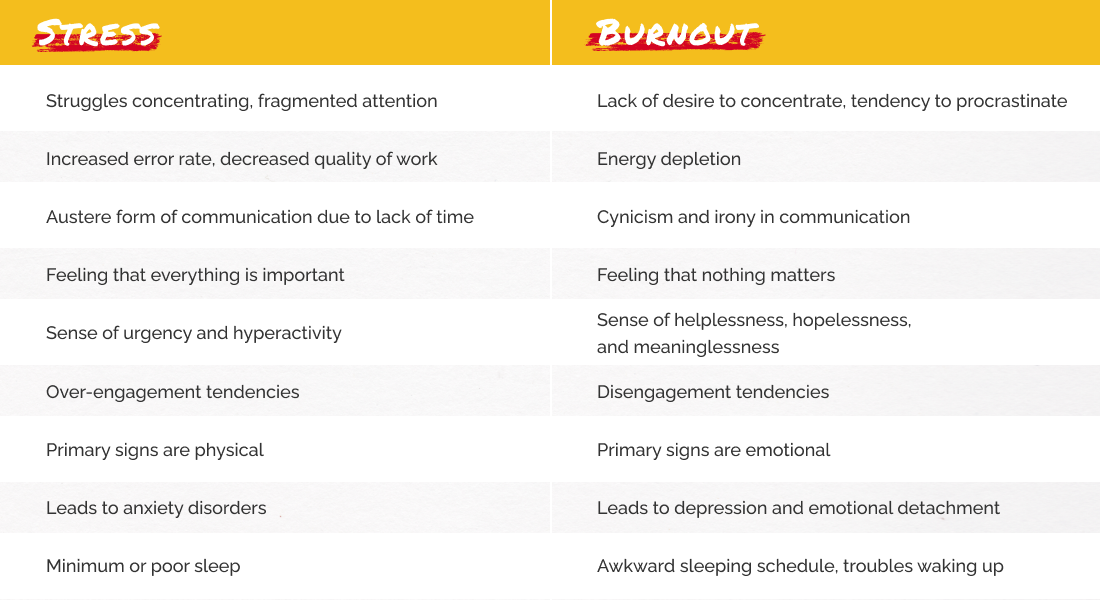WELLBEING & MENTAL HEALTH
Am I Just Tired Or Am I Burning Out? | Remote Edition

When the necessity to self-isolate forced many to work from home, hardly anyone had time to think deeply about the implications of what is happening. It is simply a matter of somewhat swimming with the flow or drowning. Amidst the pandemic, very few companies were prepared to work from home on such a larger scale, and psychological well-being was not necessarily a priority for many.
As a general rule, becoming aware of our psychological well-being is not an easy task under normal circumstances. As the matter of fact, only a few education and healthcare systems worldwide have emphasized the importance of mental health in the past decades. So it comes as no surprise that in light of such an extraordinary situation, our mental well-being was not on the top of the list for businesses at first.
But not all blame falls on the pandemic. Even before, we could observe a surging rise in burnout cases - many statistics say that over 75% of people have experienced symptoms of being burned out at work pre-COVID. The changes the new normal brought have only accelerated things. In an era of lean staffing, high-performance demand, rapidly evolving technology, and fierce competition, it is not surprising that a heavy workload combined with increased stress levels poses a silent threat to people's physical and mental health.
Old wine in a new bottle: defining burnout
The first time someone used the term burnout syndrome was in the early 1970s. The New York-based psychoanalyst Herbert Freudenberger's work shed light on many things we know today about this (occupational) phenomenon. He noticed that over time, he went from feeling inspired and engaged during his work, to be highly frustrated and tired. By comparing his symptoms with his colleagues, he concluded that something much more severe than simple fatigue was happening.
It was not until 2019 that the World Health Organization finally recognized burnout in its International Classification of Diseases (ICD-11), the bible of the field. Burnout has been officially registered as a work-related condition and its manifestations have been enlisted in three categories:
- Energy depletion or exhaustion;
- Mental detachment, negativism, or cynicism related to one's job;
- Reduced professional efficacy.
I am just tired, or I am burning out?
Over the course of our lives, we face many stressful situations. Some are insignificant, some paralyzing to a certain extent. The problem arises when people no longer identify the signs, and mental symptoms start manifesting physically. Exhaustion, for example, is a normal stress reaction but not necessarily a sign of disease. Alike, many other burnout symptoms can be easily confused with stress.
So - what is the difference between the two and how to recognize a problem before it's too late?

Even without the urge to fight or escape, our senses sharp. The body gets ready by shutting down nonessential systems to conserve all the energy. The problem emerges when stress appears not because of the fear of a lion attacking us, but the fear of losing our job or catching a disease, as these can drag along for a long tie. In normal conditions, once the danger is over, all the physiological changes cease and return to balance. But when such tensions endure for weeks - or months - physical and mental consequences seem inevitable.
Sustained unhealthy stress leads to burnout. But it does not stop there. Chronic stress contributes to heart problems, hypertension, obesity, gastrointestinal disorders, and a weakened immune system. Burnout, on the other hand, has a link to mental issues such as depression and anxiety.
Most times, burnout diminishes opportunities for positive experiences at work - therefore it is no surprise that for those transforming their homes into an office, the rise of negative emotions in the family can occur too.
How to prevent remote work burnout
1. Make wellbeing a topic, encourage & help teams find their work-life balance
Apart from wellbeing awareness, dedicate time, effort, and resources to employee wellness programs. Support people in creating a designated workspace in their houses to ensure both mental & physical wellbeing. Create a one-stop-shop with resources where people can find help for themselves, or a colleague in need.
Actively encourage people to develop boundaries between work and personal time, and to take a well-deserved time off.
Even for a trained professional, it is hard sometimes to spot the initial signs of burnout throughout face-to-face interactions. Obviously, this gets even harder when managing teams over ZOOM calls.
Luckily, thanks to LutherOne's smart tech that is continuously analyzing workforce data from common daily interactions, managers can not only get early warnings but also targeted recommendations to mitigate the risk of the situation getting out of control.
3. Invest in sharing culture
Healthy information flow and collaboration are critical for team efficiency, and thus positive performance outcomes. Sense of belonging drives people to increase their focus while encouragement and recognition drive motivation.
Open channels for seamless sharing of both work & non-work-related topics, incorporate regular check-ins in your routine and remember that team building and celebrating accomplishments.



